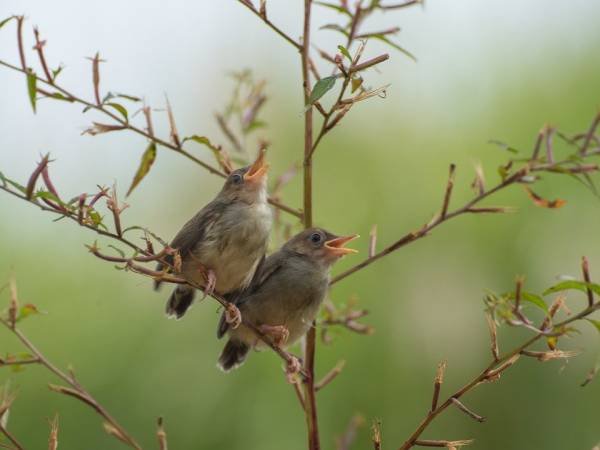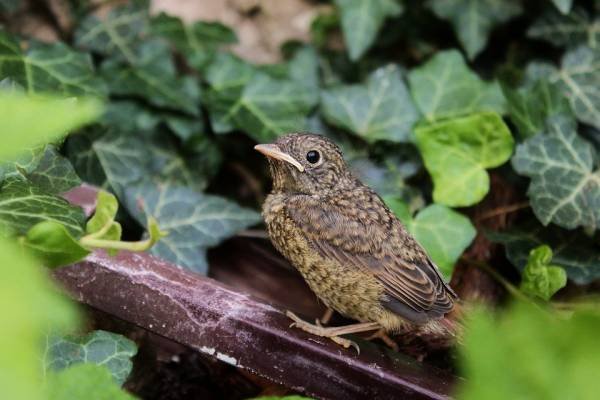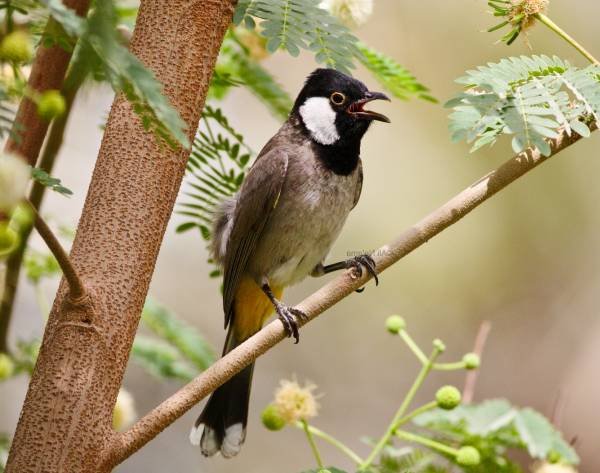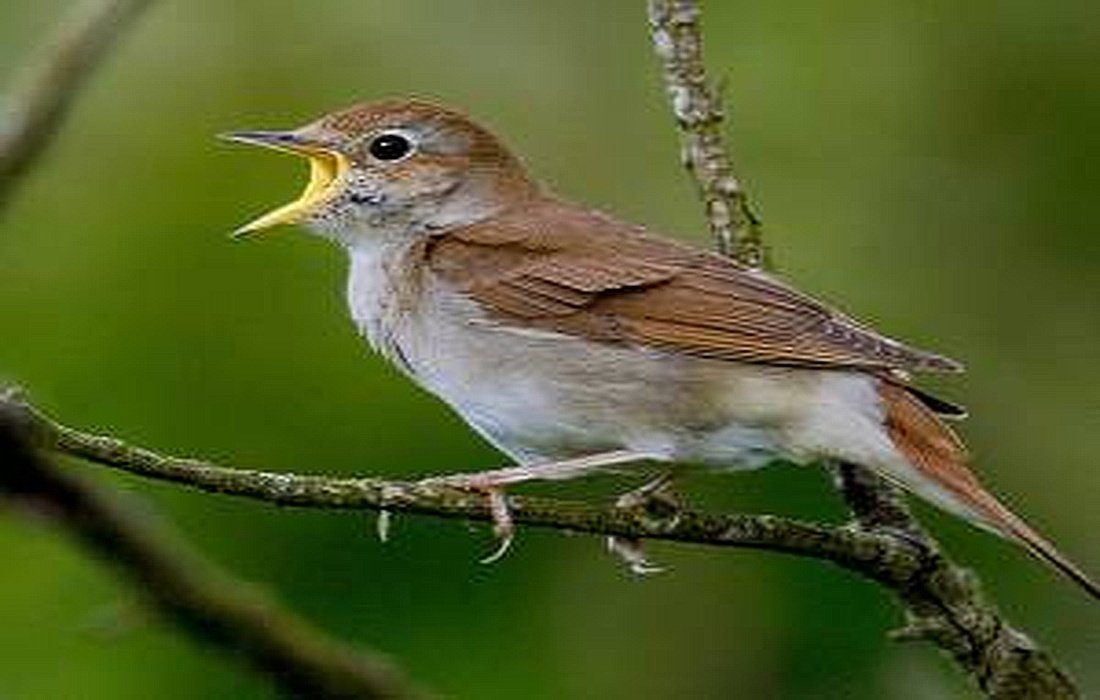How to care for nightingales.The principles of raising this melodious bird.
The nightingale is a beautiful and melodious bird, known by various names such as thousand-voiced, night singer, and nightingale. This bird inhabits the entire Middle East, and countries like Australia, Kuwait, and Qatar also breed nightingales. The nightingale’s singing is highly renowned, and it has great memory, making it a valuable symbol in Iranian literature and music.
The nightingale can easily mimic the sounds of other melodious birds, producing songs with different notes. This beautiful bird begins singing at midnight during spring and early summer among the trees, with its song audible hundreds of meters away.
Nightingales typically live in palm groves, mulberry orchards, or areas with trees and even in bushes and agricultural land. The bird is about 15 to 16 centimeters long, occasionally reaching 22 centimeters.
The feathers of the nightingale arebrownin various shades. With black eyes and a relatively long beak, it has a broad, long tail. When feeling threatened, it fluffs its tail to attract attention from lurking enemies, ensuring the safety of the female and chicks.
Types of nightingales
Nightingales exist in three different types: palm nightingale, spotted nightingale, and thousand-voiced nightingale. Each of these is further divided into three categories:
- Deep-voiced singing nightingale
- Baritone nightingale
- Standard note singing nightingale
The best, most melodious, and intelligent bird in the world is the nightingale (thousand-voiced). Before canaries came into Iran, nightingale keeping was popular. However, urban development and the reduction of gardens in residential areas, along with difficulties in nightingale breeding due to dietary needs, have led to a decline in nightingale keeping today.

Important dietary dos and don’ts for nightingales
Nightingales primarily eat small insects and reptiles in the wild. Berries are also a favorite fruit for these birds. Nightingales are insectivorous, and keeping them in a cage can be a bit tricky, and they may not reproduce in captivity.
To breed nightingales, it’s best to start at a young age, around 20 days, so they can get used to life in a cage. If they are older, you should cover the cage with a white cloth for a long time to prevent them from injuring themselves on the cage bars.
As mentioned, nightingale food consists of insects and small reptiles, and you should provide this as much as possible. Otherwise, you can use boiled chicken meat without salt or special spices, or lean ground meat in small balls, approximately 6 to 7 times a week. Feed the ground meat directly into the nightingale’s mouth.
Protein consumption is essential for nightingales, as it greatly affects their singing notes. These proteins can be found in a mix of plants likealfalfaand fruits such as raspberries, grapes, mulberries, and evenoleasteranddatesand … can be provided.
Wash them 2 to 3 times a week and provide them dry, without water, to the nightingale. You can also include vegetables like lettuce,bell pepper,celery,spinach, andcarrotsto their diet. Wash the vegetables and provide them 2 to 3 times a week for them to eat.
Nightingale reproduction
Late April and early July is the mating season for nightingales. During this time, their singing is a form of expression to attract a mate so that the female can lay eggs and reproduce. Distinguishing the gender of nightingales can be a bit tricky, and the sound of their singing plays a significant role in identifying males and females; thus, skilled people can determine their gender based on their tone and song.
During mating and reproduction, nightingales start nesting in thorny bushes and low trees. After mating, the female lays about 4 to 5 olive-brown eggs with small dark spots.
The male and female take turns incubating the eggs for 14 to 15 days, and after 15 to 16 days, the chicks break out from the green eggs and are born. Then the parents feed the chicks with worms, bringing around 250 to 300 worms daily for two chicks.
The chicks do not leave their nest until they are 10 to 14 days old and may not even fly, because the parents provide the necessary food for them until they are one month old.
As we have mentioned inSelMagznutritional supplements like ground chickpea flour,dried mulberries,hazelnuts, andalmondsmixed with a littlegrated eggand a bit of water, formed into swallowable balls, can serve as nutrition for the nightingale in captivity.

Important tips on caring for and raising nightingales
- Choose a relatively large cage for keeping nightingales, and always keep the birds in pairs.
- Regularly disinfect their food and water containers every few days, and change them at least once a year, which is highly significant.
- The birds require natural light for survival, so you should not rely solely on lamps and fluorescent lights for their illumination.
- Nightingales are sensitive birds, so keep their cage away from flowers and pots and in a temperate climate as much as possible.
- To keep your nightingale lively and cheerful, do not stress them out, and create a good spiritual environment for them away fromstressandanxiety.
- Do not purchase depressed or lethargic nightingales.
Palm nightingale
This bird resides among trees, bushes, and especially in raspberry fields and palm orchards, building nests on bushes and trees near or within residential areas. One reason for pest issues in palm trees is the palm nightingale, as it consumes the nectar from ripe dates, causing them to fall, or it lays insect eggs in the dates, resulting in significant damage.Sometimes, palm nightingales are kept as pets for their singing capabilities and their ability to quickly adapt to household environments and humans. Given a safe environment, palm nightingales will nest and breed at home.Determining the gender
of the palm nightingale:
The palm nightingale is about 18 centimeters long and quite noisy, with a black head and throat and a large white spot on its cheek, a light brown back, and a dirty gray belly, with yellow and orange coverts under the tail and a distinctly white tail tip, while its body is gray. The type found in Iran is known as Leucotis, which has a very short crest at the tip.It has dark-colored legs and claws, with traces of a crest on its head. The juvenile has spots and speckles, but can be easily distinguished by its larger brownish tail and a whiter belly compared to the black redbreast. Males and females look very similar, but males display greater boldness and more vivid plumage and eye color.
Distribution:
Most palm nightingales live in low-lying and desert areas across Iran, Pakistan, Iraq, Afghanistan, Bahrain, and parts of India. They are native and abundant in Iran, previously found in southern regions, but in recent years, they have either escaped from cages or adapted well to more northern and central areas of the country.
Song:
The palm nightingale sings a delightful and varied song, with its most beautiful tunes performed during the mating season. However, in terms of beauty and variety, it can never compare to singing birds like canaries.
Thousand-voiced nightingale
The captivating song of the female nightingale has a melancholic tune. However, the songs of thousand-voiced nightingales are generally different from one another. Some sing deeper notes, which are recognized as more desirable than others.

Thousand-voiced nightingales are only found in varying shades of brown, measuring between 16 to 20 centimeters long. They have a long beak measuring one centimeter, beautiful large black eyes, and also possess a broad, long tail.
Due to their ability to produce many notes in their songs, they are also known as thousand-voiced. The nightingale’s songs are not repetitive; each song is different from the previous one and is very pleasant.
The sweet and delightful song of the thousand-voiced nightingale can be heard in forested areas and gardens around Tehran during spring and summer. Nightingales start singing at midnight in pleasant weather and their voices can even reach one kilometer away. The thousand-voiced nightingale sings from very early in the morning until dusk during this time.
In general, nightingales reproduce twice a year, once in late April and once again in early July.
Breeding of the thousand-voiced nightingale is similar to that of other nightingales; their chicks leave the nest ten days before being able to fly and hide among the bushes and small tree branches for a while. During this time, their feeding is the responsibility of the parents until they reach a month of age.
If a nightingale chick is caught, it is kept in a cage based on its age under the following conditions:
If the chick is less than 20 days old, it should be fed 15 to 20 small balls of parrot seeds (18 seeds or parakeet seeds), and also raw, lean ground meat or crushed meat, mixed with water and placed in the mouth of the nightingale chick daily.
If the chick is one month old or older, the ground meat can be placed in its food dish so the chick can feed itself. Additionally, parrot seeds should be slightly moistened and made available at all times. Because nightingales are insectivores, maggot larvae, small grasshoppers, and ants can also be used to feed them, which significantly enhances their singing abilities.
The feathers of nightingale chicks begin to molt one month after birth, after which their new feathers obtain their true colors. The cage location should not be changed while the chicks are growing, but after this period, the cage should be moved as close as possible to trees or flowers so they can feed on the insects surrounding the trees.







